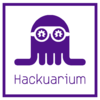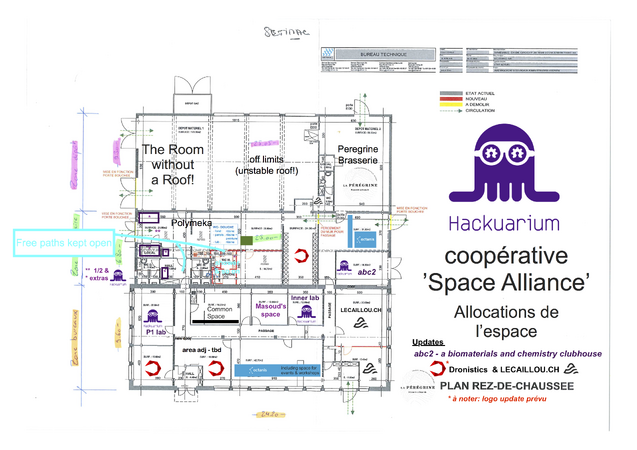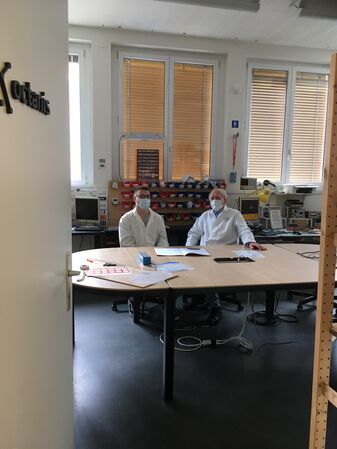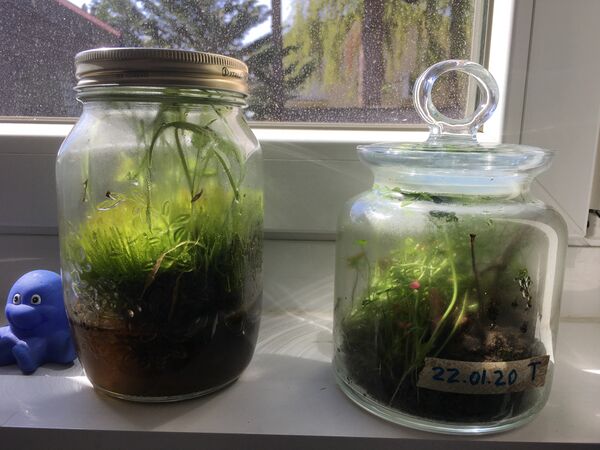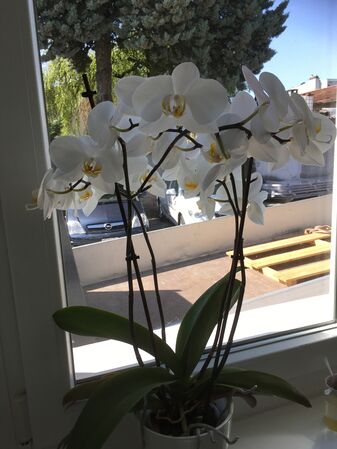New SOPs
This wiki page builds on the details in the initial P1 SOP page, which was put together initially for our old lab in Renens.
Standard Operating Procedures for Proper Use of Equipment in the Ecublens Space
Certain Hackuarium equipment could not be fit within the laboratory spaces, in particular the microbiology hood and the ultracentrifuge (the latter especially because of needs for 370V power). Instead, these are found around the corner from the Biolab. Please see the detailed lab map below in the gallery for more information.
In order to use this space safely, as our Biolab is authorised to do P1 experimentation with BSL1 organisms (and selection for antibiotic resistance markers, for example), certain extra precautions should always be followed, which these Standard Operating Procedures will set out.
A new set of simplified SOPs has been put together (2023), and laminated copies for several are available in the lab for ready inspection (in the file holder on the left corner of an upper shelf over the long drawers between the benches, at the top right in this representation of the P1 lab.) If they get splashed, simply wipe them clean. =)
These SOPs include bilingual versions for: Microbiology hood use; Glove use; Inactivation and disposal of GMOs; Sterile technique with the gas canister, and more. They can be found in this folder.
As always, if you see any modifications that should be made to these documents, or even just in the French translation, do help us fix them!
Any help with further translations is always appreciated!
Initial steps
Whenever work in the lab is being done, and one would like to go to another part of the building, for instance to use the hood or the ultracentrifuge, but also to simply go to the common room, the first rule is to sterilise hands with Sterilium by the door of the Biolab, on the 'safety shelf' to the right of the doorway. After this, one can exit the lab, and then wash hands directly with soap and water at one of the sinks by the bathrooms.
Of course, lab coats must never be worn outside of the labs in common spaces of the site! If needed, extra coats (or dispo) will be provided to take to the other areas, where personal protection is needed for other experiments (ie chemistry).
Because both of these pieces of equipment need to be plugged in with extension cords, in particular a large one for the ultracentrifuge, cautionary signs will be placed in clear view, to avoid any tripping hasards.
Use of the small sterile hood - not for GMOs!
After taking the usual initial precautions (cleaned hands, no lab coat):
The hood should be wiped down with alcohol, turned on for at least 15 minutes, and again wiped down with alcohol before beginning any manipulations. The material to be manipulated (plates strains) will be prepared in the biolab, and placed in a sealed plastic box and wiped down with alcohol on all outer surfaces before going to the the hood.
After all work is complete (streaking, culture inoculation etc), the materials should again be sealed in the box to be brought back to the lab space (and put in the incubator for cultivation, for example).
Because this hood only protects the work, not the worker, it must not be used for experiments with GMO organisms.
Instead, the gas canister in the P1 lab is used, for a sterile zone for experimental manipulation. More SOPs for the lab are found here.
Use of the ultracentrifuge
Following all the initial precautions in leaving the lab, the prepared materials to be centrifuged will be taken out in a box, as in the above description: briefly, the sealed box is wiped down with alcohol before taking it out of the lab.
Care must be taken to have balanced samples for the spin, of course.
After the run is complete (i.e. 5k rpm for 10min to pellet a bacterial culture in 200ml bottles), the materials should again be placed in the box to be carried back to lab.
Supernatent liquids will be poured out carefully, and disinfected properly for disposal with some bleach.
Going back to double check that the rotor has not been contaminated, and cleaning properly with (bleach) water then alcohol, if needed, is the next step to not be forgotten.
Preventing covid-19
Always wash hands before touching your face!
Wear a mask if physical distancing from others is not possible.
If soap and water is not available, use disinfectant...
This is the 'diy' recipe from the WHO, adapted for the hydrogen peroxide and volume of alcohol readily available in Swiss pharmacies:
150ml 96% Ethanolum (includes 0.1% camphor)
7.51ml H2O2 (3% solution)
2.61ml glycerol (98% solution)
9.88ml dH2O
(final volume: 180ml)
to note, nov2023 - of course, this whole part is maybe considered too late to think about, but use of isopropyl alcohol seems a better idea than such mixes with ethanol! (even worse is the alcohol à bruler for fondue makers?) need to confirm if the 70% isopropyl alcohol (as we currently have in the lab) has been well tested for covid too...
Getting the best out of the current space
Here is an overview of the P1 lab
Project boxes from shelf areas are used to store project specific equipment, so things aren't left lying about the lab...
Please make sure to tidy the space after manipulations, so the next people coming to do something are able to do what they need to do!
Separate out waste and always follow the safety guidelines!
Here are the same guidelines in French.
If something will be left out or on (i.e. the plates you just poured, the incubator), label with instructions, dates and initials, so your work will be safe and no one can complain... :)
Make sure to do risk analyses, especially in projects that involve GMOs, but also in general. This community biolab document can be of great help, when you start in on this essential risk assessment work.
Please use this form to help document your risk analyses efforts and save any other analyses done. (Try this possible model for your project.).
Gallery
The coop space now includes 3 rooms for Hackuarium, plus a bit more.
Here is a simplified view of the overall coop building in Ecublens...
Maurice and his student, taking precautions in the Octanis space during the covid-19 pandemic.
Terrariums by Vanessa and Tatiana.
and the gorgeous orchids - that only lost their flowers finally in June 2020...
This will take you back to more information for the P1 lab use and biosafety.
